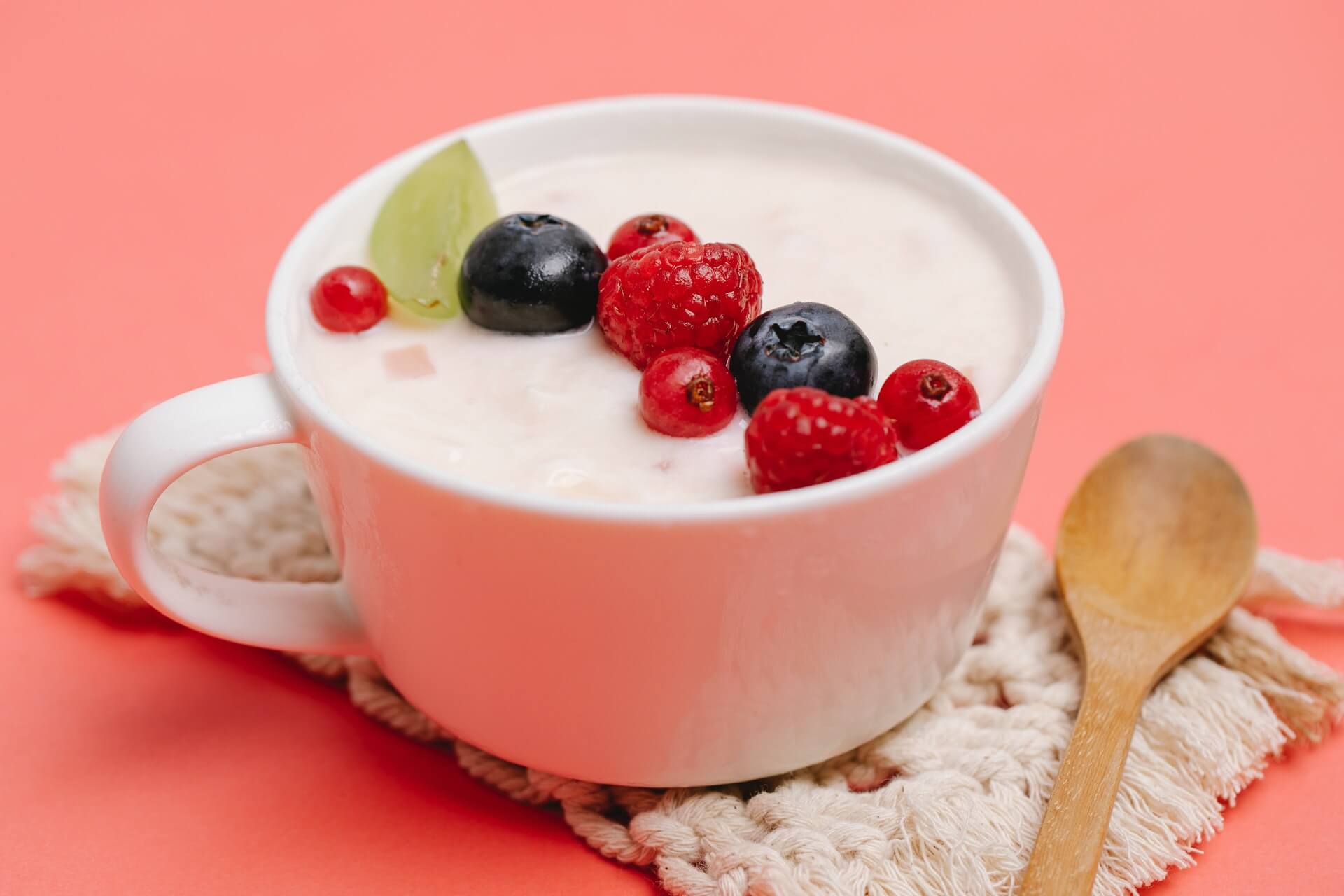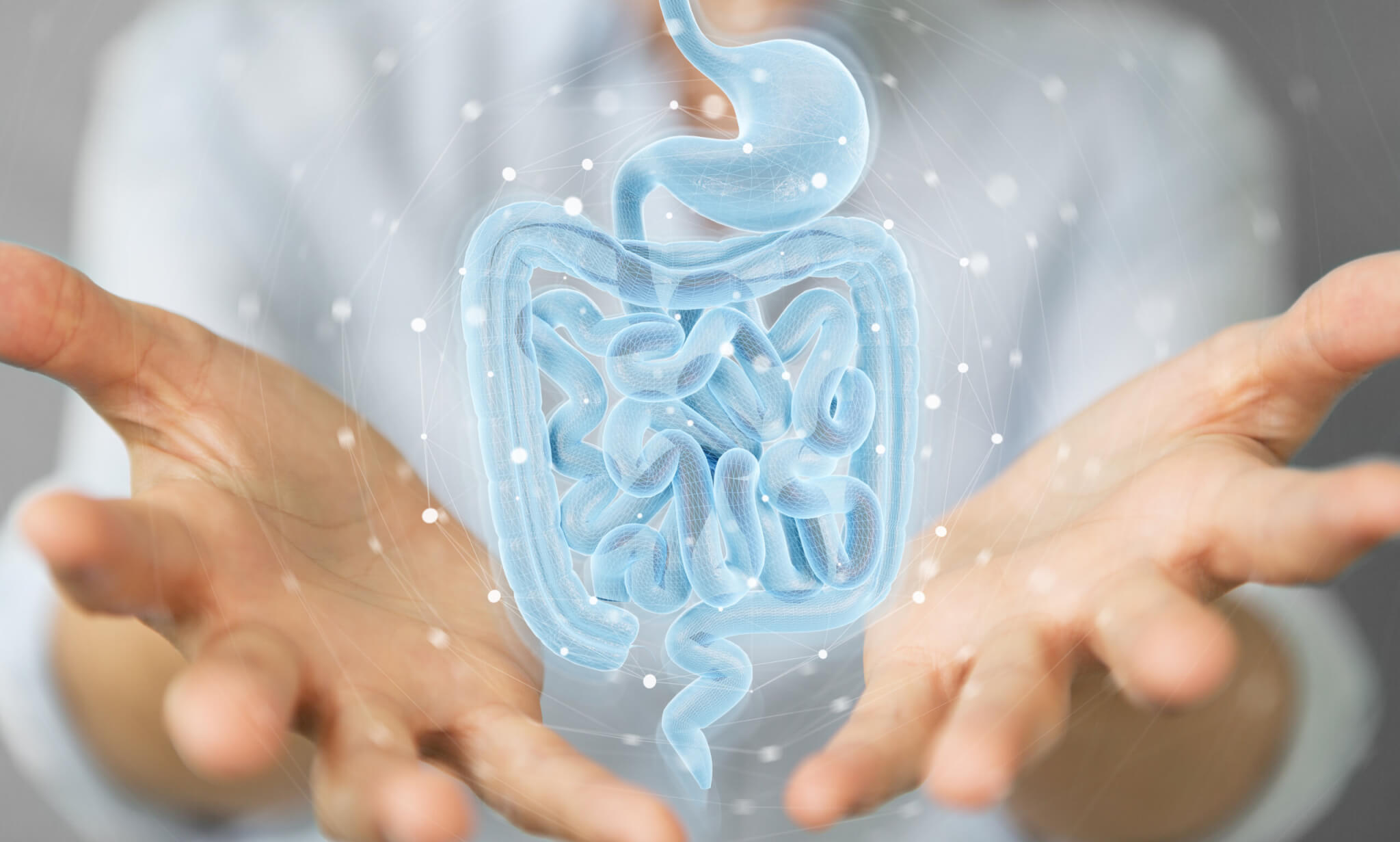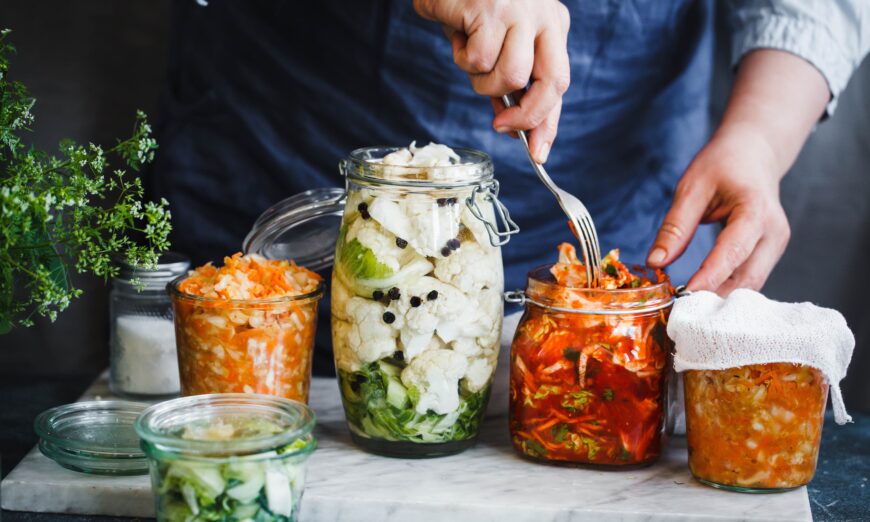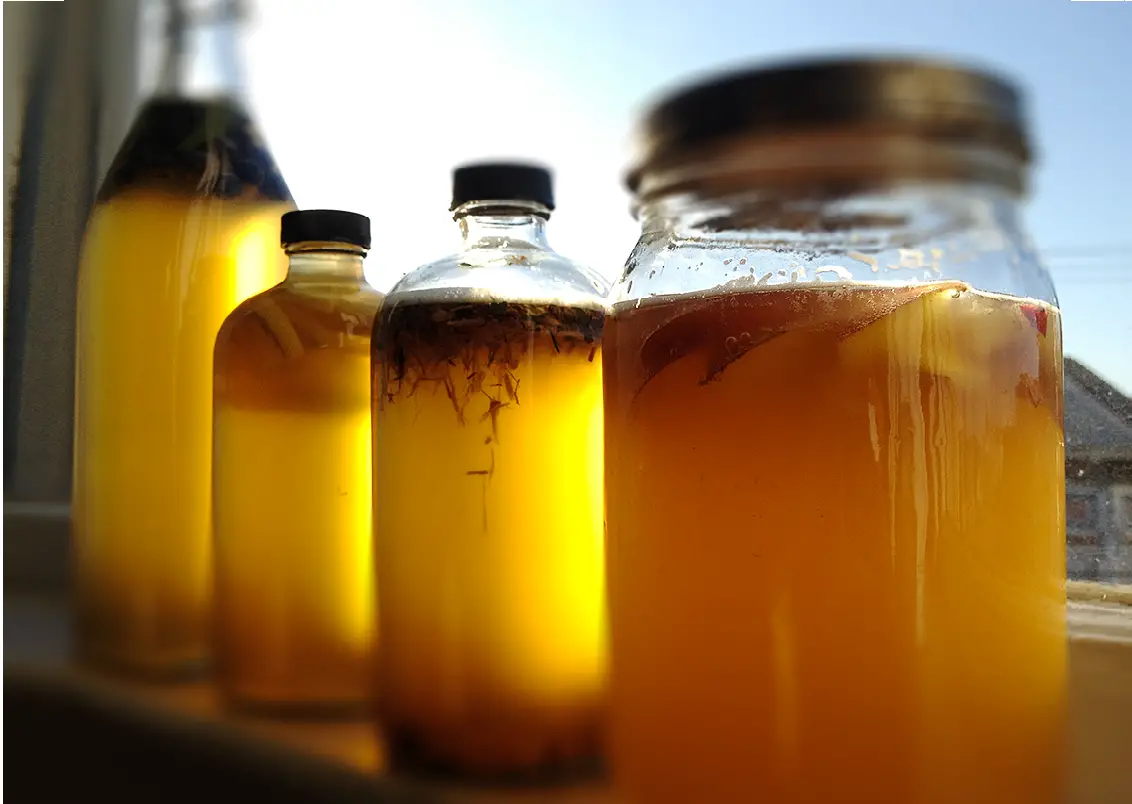
Fermented foods and beverages, such as yogurt and kefir, are gaining popularity as non-pharmaceutical, health-enhancing agents. So, what exactly are these foods and why are they so good for your body?
Fermentation refers to the slow decomposition of organic substances (foods) due to microorganisms, also called microbes. Microbes are the smallest and simplest forms of living matter, visible only with a microscope. Fermentation in food processing is the conversion of carbohydrates to alcohols, carbon dioxide or organic acids.
The chemical changes which are a part of fermentation can be helpful or harmful. Applying the word “fermentation” suggests that there is a desirable change taking place, such as the production of beer and wine. Fermentation has been a method of choice for the preservation of foods for thousands of years and is still in practice in developing countries. When fruits and vegetables are abundant, fermentation preserves them for times of scarcity. The process requires no tools or technology, nor excessive labor.
Fermentation Agents
There are three types of microorganisms which can cause fermentation:
- Bacteria areusually Lactobacillus species, essential for both initiating and maintaining the fermentation process. They convert carbohydrates into lactic acid. Acetobacter species, which produce acetic acid, are also common, especially in the fermentation of fruits and vegetables.
- Yeasts, usually Saccharomyces species, are used for conversion of carbohydrates to alcohols. This type of yeast is familiar – it causes bread to rise before baking.
- Moldscan cause food to decay but can also act as preservatives.
Variation in the types of microorganisms used for fermentation produces distinct flavors and textures in foods. Many ethnic groups incorporate fermented products into their traditional foods and methods of preparation, unique to their cultures.

Types of Fermented Foods
Dairy products are fermented primarily by Lactobacillus species. The bacteria produce lactic acid from lactose – the main carbohydrate (sugar) in milk. Fermentation increases acidity of the products, which can inhibit growth of undesirable microorganisms. Other genera which may be present include Streptococcus, Pleonastic, Enterococcus, and Lactococcus. Bifidobacteria are also common in fermented milk products. Most yogurts we’re likely familiar with are produced with a culture of L. Delbrück, subp. Bulgaricus, or S. thermophiles.
During the fermentation of dairy products, many desirable substances are produced or increased by the metabolic activity of the lactic acid bacteria Propionibacterium, yeasts, or molds. These include vitamin B12 and folic acid. Biotin may increase with fermentation as well. These dairy foods have additional peptides which are active. Claims have been made that the bioactive peptides can lower high blood pressure and act as antimicrobial, antioxidative, and immune system modulators.
The action of lactic acid bacteria on lactose also produces galacto-oligosaccharide, an indigestible carbohydrate which can be beneficial to health. It promotes the growth of beneficial bacteria in the gut, which is a prebiotic effect.
Yogurt is a rich source of essential minerals including calcium, magnesium, potassium, phosphorus, and zinc – their concentration is 50 percent greater in yogurt than the concentration in milk. For many people, the minerals in yogurt are also more bioavailable – more digestible, with better absorption than in milk. It can often be digested easily by individuals with lactose intolerance.
Yogurt is also a rich source of essential amino acids. The pre-digestion of milk proteins by the chemical changes of fermentation increases free amino acids, the building blocks of proteins. Amino acids are more easily digested than complex proteins.
Multiple studies have found that regular ingestion of fermented milk products is associated with a decreased incidence of several diseases. Some of these include bladder cancer, periodontitis, and heart disease.
Harmful compounds may be found in fermented dairy products which have been contaminated by mycotoxins (fungi) and biogenetic amines, but there are strict regulatory standards set by international agencies. Effective methods for detecting undesirable substances have been developed; most harmful compounds are identified before the products reach consumers.

Fermented produce is endemic to many cultures and geographic regions. It is an easy method for improving safety and boosting nutritional value, as well as extending the length of time the products can be stored. The most common fermented vegetables include:
- cabbage, as sauerkraut and kimchi
- cucumbers, as pickles
- olives
Fermentation of vegetables occurs spontaneously from bacteria present on the surfaces of the produce. Starter cultures may be used to speed up the fermentation and ensure that the final product is reliable. The starter culture prevents failure of fermentation and inhibits rotting with disease-causing microorganisms.
Fermentation by lactobacilli enhances the nutritional value of vegetables. Research with maize (corn), soybeans, and sorghum showed that fermentation reduces phytate content. Phytates are known to lessen iron and zinc absorption. Fermentation of maize also increases the bioavailability of iron.

What’s the link between fermented foods, probiotics, and the microbiome?
Advances in technology, including DNA sequencing, are fueling a burst of understanding of the essential and vital roles and significance of the complex environment of microorganisms in the human gastrointestinal (GI) tract. Some important terminology may be new to most consumers, but will surely become familiar, including:
- microbiota – microorganisms within the GI tract
- genome – all the chromosomes of an organism, with all the information needed to build that organism and its inheritable traits
- microbiome – the total genome content of the microbiota
- probiotics – live microorganisms which reproduce within the GI tract and add health benefit(s) to the host
- food matrix – nutrients and non-nutrient parts of food and their interactions
Much of current research is focused on identifying the effects of the bacteria of the microbiota in health and disease, especially the effects of changing the types and numbers of microorganisms in the GI tract. Greater understanding will reveal new ways of using the knowledge to enhance health and change the courses of diseases.

Digestion affects the microbiome
Diet is one of the most significant factors in determining the environment within the GI tract and is one of the most effective ways of changing the numbers and types of microorganisms. Fermented foods have an abundance of bacteria which function as probiotics, yielding health benefits in the host.
Recent research suggests that there is a core population of bacteria within the gut, as well as a variable population of microorganisms, most ingested with food. There is uncertainty, however, about the survival of live organisms ingested in food. If they are to have beneficial effects, they must be able to survive passage to the intestines. Factors which influence survival of the ingested microorganisms include acidity, oxygen, temperature, moisture, storage temperature, and concentration of carbohydrates.
Fermented foods must survive the mouth, esophagus (the muscular tube for food to pass from mouth to stomach), stomach and duodenum (the first part of the small bowel). In the mouth, chewing and enzymes in saliva begin the breakdown of foods and bacteria. The stomach is an extremely acidic environment, with a pH of less than 3. It also supplies potent, destructive enzymes, which break down proteins into smaller amino acids. Most microorganisms do not survive the enzymes and potent acids which break down proteins in these parts of the GI tract.
As ingested substances travel through the small intestine, the environment becomes less acidic, with a pH greater than 6, but the microorganisms are exposed to bile and potent enzymes, including amylase (breaks down starches into simple sugars), lipase (breaks down fats), pepsin and protease (additional protein breakdown). Some bacteria can survive the hostile environment and even grow in the small intestine. A greater number and concentration of bacteria in the ingested foods are correlated with greater survival. The surviving bacteria continue passage to the colon, where they adhere to the lining of the large intestine.
What are the health benefits of probiotics and fermented foods?
Some reported beneficial effects of probiotics (inclusive of fermented foods) include:
- relief of constipation
- improvement of diarrhea
- improvement of symptoms of inflammatory bowel conditions, such as Crohn’s disease, ulcerative colitis, and necrotizing enterocolitis
- improvement of symptoms of irritable bowel syndrome
- prevention of allergic disease in infants
Supplemental probiotics have been shown to:
- enhance immune system function
- improve symptoms of lactose intolerance
- prevent infection with disease-causing microorganisms
Several suggested mechanisms by which probiotics influence health include:
- numbers of probiotic bacteria compete with and overwhelm disease-causing bacteria
- preventing attachment of disease-causing organisms to host cells of the intestinal lining
- strengthening the mucosal barrier
- releasing immune-cell-stimulating molecules (called cytokines)
- releasing anti-inflammatory molecules (also called cytokines)
- production of organic acids
- production of hydrogen peroxide
- production of bacteriocins (amino acid strings that inhibit growth of other bacteria)
How can people get their hands on more fermented foods?
Many consumers ferment their own fresh foods, which can be less expensive than buying commercially prepared fermented foods. There are many blogs, magazines, books, and courses for guidance in the process of fermenting foods.
Fermented foods are also purchased ready for consumption at natural food stores and supermarkets. Their availability is growing quickly. Fermented foods contain living organisms that must be kept cool to survive. Buy only fermented foods which have been kept refrigerated.
Countless foods can be fermented. Some of the most common are:
- Produce – beets, radishes, tomatoes, onions, garlic, kimchi, green beans, sauerkraut
- Condiments – ketchup, relish, salsa, chutney
- Dairy products – kefir, cultured buttermilk, some cheeses, yogurts; yogurt can also be made with coconut milk
- Others – miso, tempeh, tofu, soy sauce
Processed foods, fast-food restaurants, and sugar-sweetened beverages have become mainstream commodities in both the developed and the developing world. With changes in food consumption, some health issues which were unknown to some countries and regions are now prevalent. These include diabetes, cardiovascular disease, obesity, and more.
Domestically, the same health issues are escalating in frequency. Fermented foods have much to offer, especially in association with gut microbiota. More work is necessary to identify and understand how traditional, fermented foods, and new fermentation techniques, can be health-enhancing.









![[IMG]](https://i0.wp.com/www.sandiegocondosin92101.com/assets/blog/cheese_000008808279Large.jpg)
